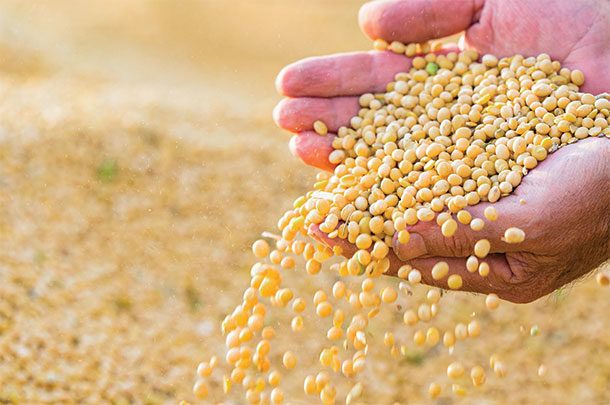Incorporating soybeans and their byproducts into dairy cattle rations is a fairly common practice. Soybeans are an excellent source of essential amino acids and complement most forages, but they do have some limitations.
Depending on how they are processed, they can provide high-quality protein, energy, fat and fiber.
Soybeans add protein and energy to the ration. If soybeans have been properly heat-treated, they can provide additional rumen-undegradable protein (RUP) and fat. Soybeans that have not been heated provide a source of rumen-degradable protein (RDP). There is no question that soybeans and their byproducts can provide various nutrients to the rations of dairy cattle. However, as with any feed, there are some limitations that need to be recognized so the dairy cow can reap the full benefits provided by soybeans.
You may want to consider feeding homegrown soybeans to help reduce purchased feed costs. If roasting beans is economical in your area, it can be cheaper to feed homegrown soybeans to partially replace the protein needs of the cow instead of purchasing all soybean meal to bring onto the farm, especially in the current market.
Heat-treated soybeans
On a dry matter basis, heat-treated soybeans can range from 33% to 44% crude protein (CP) and 15% to 22% fat, with a moisture content of 5% to 12%. For properly heated soybeans, an average RUP value as a percent of CP is 50%. The two most common methods of heat treatment are roasting and extrusion; both offer advantages as well as disadvantages.
Roasted beans
Roasted beans are a very popular soybean feeding source, as they supply both RUP and fat. They work well in most forage-type rations, providing the greatest benefits as part of heavy hay crop silage diets. They can be included in the ration as up to 18% of the total dry matter. However, in many situations and when used with other concentrate ingredients, RUP and/or fat will limit the amount of beans that can be fed. We most commonly see roasted bean inclusions of 3 to 4 pounds (as-fed inclusion) in lactating cow rations.
There are two main types of roasters used in the field: drum roasters and high-temperature air dryers. With drum roasters, soybeans are dropped into a rotating drum whose air temperatures can range from 400ºF to 600ºF. The soybeans remain in this hot-air environment for approximately one minute before exiting. If beans remain in the roaster for longer than one minute, they can get scorched; however, the amount of damage incurred when beans are scorched is typically minimal.
In high-temperature air dryers, soybeans are conveyed over a perforated floor through which hot air is blown. Scorching is less common with this process, and it also may be more energy-efficient, but the equipment associated with high-temperature air dryers is usually more expensive.
The main objective in the roasting process is to provide heating evenly among the beans and allow them to be steeped or held without cooling for an additional amount of time. Soybeans passed through a drum roaster can produce a consistent product. The most commonly used method is open-flame roasting. Open-flame roasting is where more variation occurs with respect to RUP levels.
Some of the factors that can affect RUP levels with the use of open-flame roasters include the bean moisture content, cleanliness and the environmental temperature. It is not unusual to see RUP range from 40% to 65% of the CP. This might explain some of the variable results observed in the milk production response in both controlled and field research.
Research results have demonstrated how RUP and lysine availability can vary among different types of heat treatment. It appears that the optimal heat treatment for soybeans which will be fed to lactating dairy cattle involves heating the soybeans to 295ºF and then steeping them without cooling for an additional 30 minutes. The steeping temperature will always be lower than the temperature of the soybeans exiting the roaster, since the soybeans will be losing moisture through evaporation. This means the temperature of the steeped beans will be 10 to 20 degrees cooler, depending on the moisture of the beans.
Measuring for proper heat treatment
Improper roasting procedures could lead to variations in the production response of animals fed roasted soybeans. If soybeans are roasted with too little heat, then the amount of RUP supplied in the ration could be greatly overpredicted. On the other hand, using too much heat could result in a Maillard reaction, which makes protein unavailable in the small intestine. Improper roasting procedures can also diminish the amount of lysine available post-ruminally. For these reasons, it is necessary to implement some quality control measures to ensure dairy producers are getting the most value possible out of feeding their roasted beans.
Common forage labs offer tests that can determine whether heat treatments have been adequate or excessive. A common procedure is the urease activity test; the results are expressed as an increased unit of pH. Values of 0.05 to 0.30 are reasonable evidence the beans have been properly cooked. If the beans are used in a TMR or a high-moisture grain mix containing urea, a range of 0.05 to 0.10 is preferred.
Another popular assessment is the protein dispersibility index (PDI) test. The solubility of a feed ingredient decreases as the heat exposure time and temperature increase. This procedure can determine how much heat soybeans were exposed to during roasting. The ideal PDI value for optimally heated soybeans ranges from 9 to 11. Soybeans with a PDI value greater than 14 are considered underheated. A major disadvantage of the PDI system is: Its sensitivity decreases as the optimum heat treatment is approached. For example, as the PDI moves from 14 to 9, there may be an increase in RUP and post-ruminal available lysine. Even a small change could affect the PDI value of the heated soybeans. This lack of sensitivity is a weakness in the PDI procedure.
Another great way to analyze heat treatment is the Ross RUP analysis, which can be performed at various forage laboratories. This test can help determine accurate percentages of digestible RUP and total RUP. This assay can also further identify whether any underheating or overheating occurred during roasting.
Particle size of roasted soybeans
The majority of the research indicates that particle size influences the protein degradability characteristics of roasted soybeans. The particle size of the roasted soybeans can affect how a high-producing dairy cow utilizes protein. The primary concern is that small-particle protein is more likely to degrade rapidly in the rumen than large-particle protein.
The results of several reputable studies indicate that, in order to retain the RUP value of the feed, the optimal particle sizes of roasted soybeans are whole/half and half/quarter. In TMRs, the whole/half particle size should result in little to no separation. However, in grain mixtures or supplements, a half/quarter particle size may work better. If the goal of feeding roasted soybeans is to supply RUP, then grinding and pelleting are not recommended.
References omitted but are available upon request by sending an email to the editor.










